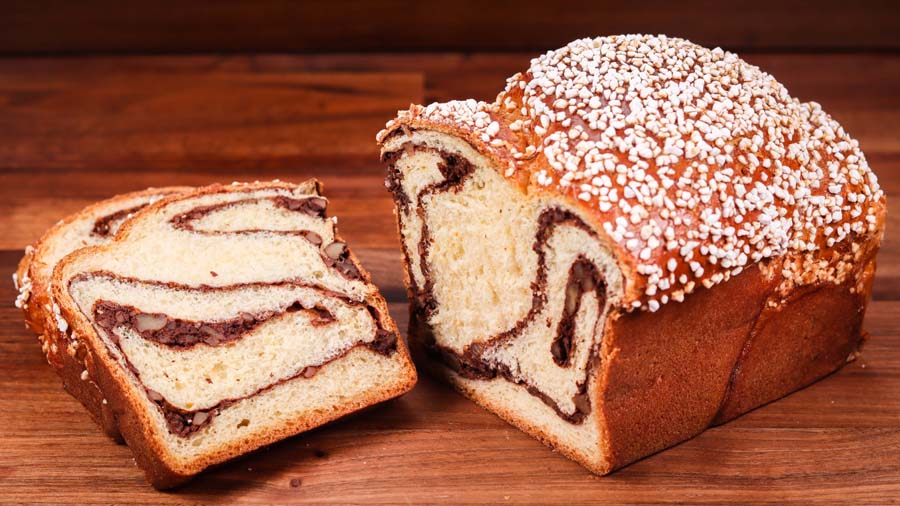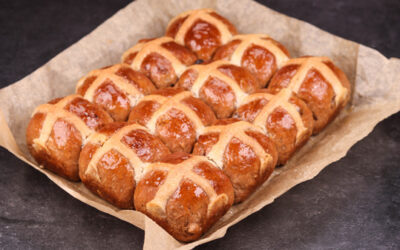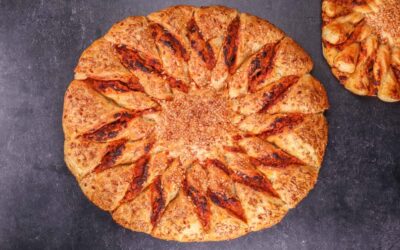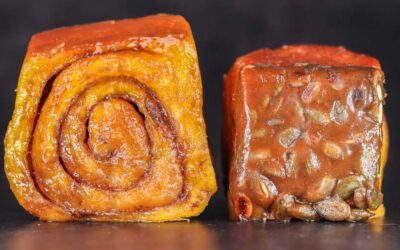This bread has all the great Christmas bake characteristics. It is extremely light and fluffy; it is flavoured with citrus and decorated with sugar. And it has a nutty filling inside it.
And when I say it is light and fluffy, I mean it is one of the lightest and softest loaves I’ve made as of late. This amazing texture is achieved using two methods – scalding (yudane) and a flying sponge.
I have used the scalding method in quite a few recipes on the channel and there is a full video about this method which you can find in the Principles of Baking playlist. In short, flour is mixed with boiling liquid to essentially cook it. The starch of the flour is gelatinized which gives the resulting bread an extremely soft crumb and prolongs its shelf life.
The second method used is a flying sponge preferment. It is a quick preferment which propels this dough and makes it rise well and achieve great volume and an open crumb.
Some traditional recipes use Turkish delight in the filling, but I could not find any in my local shops, so I left it out. If you want to add it, then use 100g (3.5oz). Dice it and roll it into the dough when shaping.
This recipe makes a loaf that fits perfectly in a 900g (2lb) loaf tin.
Watch the video down below for detailed instructions.
Ingredients
For the scald (yudane) –
50g (1.75oz) white bread flour
50g (1.75oz) boiling milk
For the flying sponge –
85g (3oz) milk
4g (0.14oz) instant dry yeast or 4.8g (0.17oz) active dry yeast or 12g (0.42oz) fresh yeast
50g (1.75oz) white bread flour
For the main dough –
150g (5.3oz) white bread flour
40g (1.4oz) egg yolk (2 yolks)
40g (1.4oz) sugar
50g (1.75oz) softened butter
10g (0.35oz) vanilla paste
5g (0.17oz) salt
1 orange worth of zest
1 lemon worth of zest
For the filling –
2 egg whites
40g (1.4oz) sugar
20g (0.7oz) cocoa powder
100g (3.5oz) chopped walnuts
To decorate –
1 egg for glazing
40g (1.4oz) pearl sugar or other sugar to sprinkle on top
The flour I use has a protein content of 13%. If your flour is weaker, then you may need to lower the hydration.
If you are using active dry yeast, then you may need to let it sit in the milk for 10 minutes before adding the flour or else it could take a lot longer to make the preferment rise.
If you are curious about why the dough contains butter, egg, and sugar, click the links to learn more about the effects those ingredients have on bread dough.
Method
- Make the scald. Mix the flour with boiling milk until there is no dry flour left. You must boil more milk than needed to account for evaporation. Weigh the boiling milk as you pour it into the flour to get the right amount.
- Cover and leave the scald to cool down completely. You can even refrigerate it.
- Make the filling. Whip the egg whites and sugar to the stiff peak stage. Use a mixer if you have one. Mix in the cocoa powder. Finally mix in the chopped walnuts. Leave in the fridge for later.
- Make the preferment. Combine the milk, yeast, and flour. Cover and leave to rise for 1 hour or until well puffed up.
- Make the dough. Add the salt, sugar, lemon zest, orange zest, and egg yolks to the sponge. Mix well to dissolve the salt and sugar completely. Add the scald and the flour. Mix to a dough.
- Tip the dough out on the table and knead using the slap & fold kneading method for 3 minutes. Tear in the butter and continue kneading for 6 minutes. *Desired dough temperature 25C – 26C (77F – 79F). If your dough is warmer, then it will ferment more rapidly. If it is cooler, then it will take longer. Adjust proofing time accordingly.
- Cover and ferment for 45 minutes.
- Fold.
- Ferment for 45 more minutes.
- Divide the dough in two equal pieces. Roll it out one by one and spread with the filling. Add the Turkish delight at this point if you are using it. Roll the dough up and seal it.
- Twist the two rolls around each other. Place in a non-stick paper lined baking tin.
- Final proof 2 – 2.5 hours or until the loaf rises above the rim of the tin.
- Glaze the loaf with egg and sprinkle with sugar.
- Bake at 160C (320F) for 45 minutes or until the internal temperature reads above 94C (200F).
Leave to cool down and enjoy!
Keep in mind that the conditions in each kitchen are different, so fermentation times may vary for you. It is up to the baker to control the bread and react accordingly.
Your oven may be different too, so your baking time may vary.
Watch the video here



